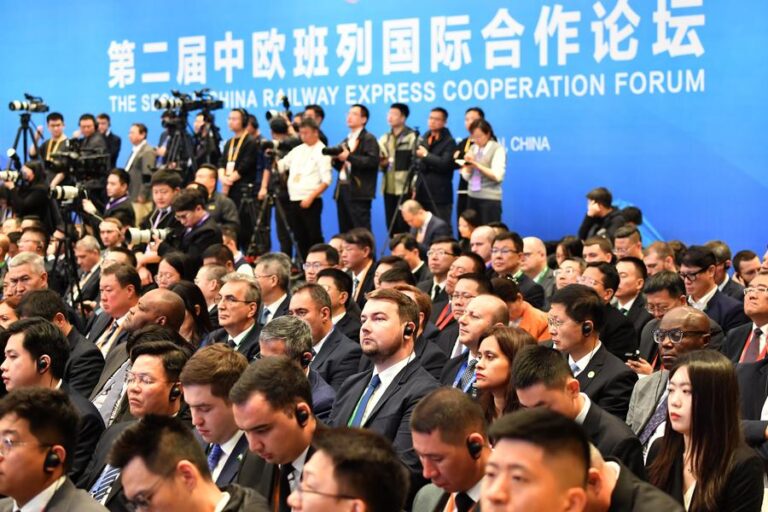* China-Europe freight trains — dubbed the modern “steel camel caravans” — have established a vast logistics network across Eurasia.
* As a cornerstone project of the BRI, China-Europe freight trains have evolved into an international logistics brand characterized by its extensive reach, driving force and influence.
* The China-Europe freight train service has catalyzed the growth of port and hub economies.
XI’AN, Nov. 24 (Xinhua) — Over 2,000 years ago, during the Western Han Dynasty (202 BC-25 AD), Chinese envoy Zhang Qian embarked on a journey from Chang’an, known as Xi’an today, to the Western Regions via Central Asia. His expedition laid the foundation for the ancient Silk Road, creating an early model for transcontinental exchange.
Today, China-Europe freight trains — dubbed the modern “steel camel caravans” — have established a vast logistics network across Eurasia. This initiative embodies both the legacy of the ancient Silk Road and the Belt and Road Initiative’s (BRI) vision of enhancing infrastructure connectivity and trade facilitation.
Since its launch, the service has expanded its operational network to 232 cities in 26 European countries and over 100 cities across 11 Asian countries, completing nearly 120,000 journeys as officially announced at the second China Railway Express Cooperation Forum in Xi’an, now the capital of China’s Shaanxi Province.
As a cornerstone project of the BRI, China-Europe freight trains have evolved into an international logistics brand characterized by its extensive reach, driving force and influence.
WELL-DEVELOPED NETWORK WITH HIGH EFFICIENCY
On Wednesday, a China-Europe freight train departed Xi’an for Prague, Czech Republic, inaugurating a new fixed-schedule service that slashes transit time to just 11 days and four hours — a 39 percent reduction from the previous 18-day journey.
The train, carrying 55 containers of auto parts, household appliances, and other goods, operates on a meticulously planned timetable with assigned train numbers, standardized routes, and fixed departure and arrival times across the countries along its path. This service model, first introduced in 2022, was designed to enhance cross-border rail efficiency.
“The key advantage of this connection lies in its very short transit time and highly precise schedule throughout the entire route from China, traversing Kazakhstan, Russia, Belarus, and also within the European Union,” said Martin Koubek, director of Silk Road & CIS at METRANS, an intermodal logistics service provider based in the Czech Republic, during an interview at the forum.
The forum held last week announced over 100 cooperation outcomes, including seven new China-Europe freight train routes that will operate on full timetables, reducing travel time by over 30 percent on average. This enhanced efficiency positions the service as an ideal solution for high-value goods, such as photovoltaic panels and marine diesel engine parts.
A report released at the event underscored that the service’s extensive and efficient network continues to expand and mature, bolstered by ongoing investments in capacity expansion and streamlined customs clearance procedures.
Guo Zhuxue, chairman of China State Railway Group, attributed the service’s success to enhanced international cooperation and optimized operational processes, which have not only balanced freight volumes in both directions but also cut rail rates by over 40 percent since the service’s inception.
“The rapid development of China-Europe freight trains expands international logistics capacity, offering diversified transport options and reducing reliance on maritime routes,” said Nguyen Chinh Nam, deputy general director of Vietnam Railways Corporation.
FROM LOGISTICS CHANNEL TO ECONOMIC CORRIDOR
While transforming inland regions and countries into pivotal transportation hubs, China-Europe freight trains have emerged as a critical conduit for global expansion of companies with landlocked locations, while also weaving together a global industrial chain spanning smart manufacturing, modern agriculture, and high-end equipment across Eurasia.
Capitalizing on the strategic advantages of the freight train service, Chinese home appliance giant Konka has established a smart appliance industrial park near the Xi’an international port station. By the end of September, the project had exported 239,600 white-goods appliances via China-Europe freight trains.
“The rail service slashes shipping time from 45 days by sea to just one or two weeks and now accounts for over 60 percent of our export volume,” said Yuan Gen, vice general manager of Shaanxi Konka Smart Home Appliance Co., Ltd.
The China-Europe freight train service has catalyzed the growth of port and hub economies, as highlighted in the report.
This transformation is exemplified by Kars in eastern Türkiye, which has evolved from a gateway for freight trains entering the country into a pivotal logistics and transit hub.
Mayor Ötüken Senger emphasized that Kars now presents substantial opportunities for trade, warehousing, and industrial development.
“Today, regional logistics hubs are no longer mere physical transfer points for goods. They are evolving into strategic nodes in a global ecosystem that integrates smart supply chains, sustainable transport and digital innovation,” he added.
(Video reporter: Zhao Yingbo; video editors: Wang Houyuan, Hui Peipei and Liu Ruoshi) ■

